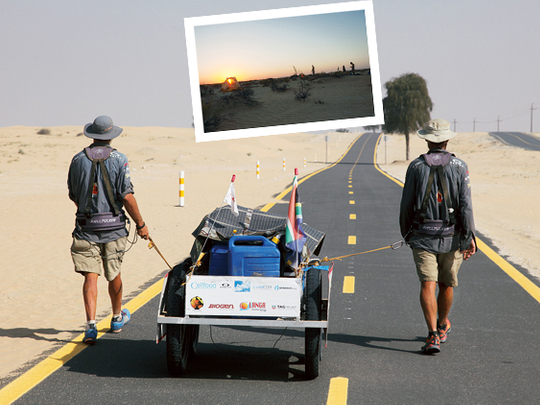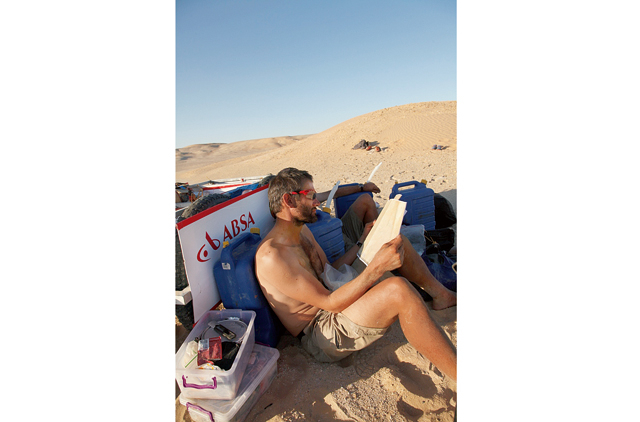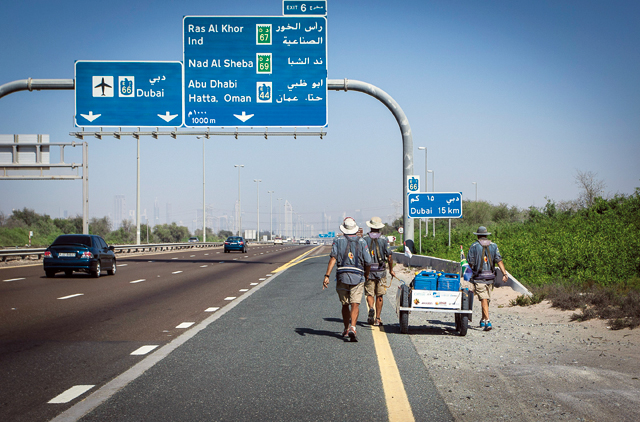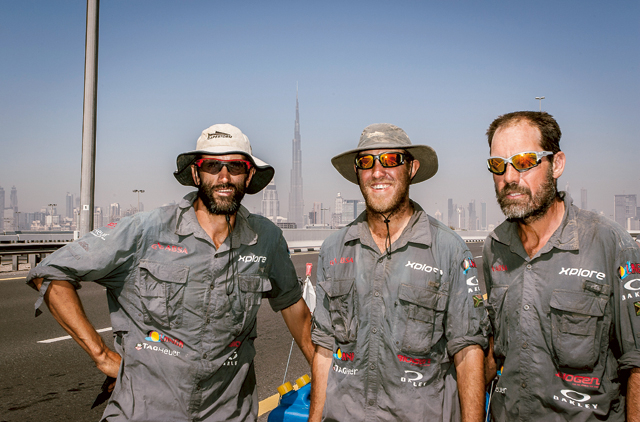
It was barely 10am, but the temperature was already in the mid-30s. The hot
air was dry and the sun was blazing down ferociously on three men who were trudging through ankle-deep sand dragging a 400kg cart loaded with supplies. Their mission: to walk across the Empty Quarter – the world’s largest sand desert – from Salalah in Oman to Dubai, a distance of around 1,208 kilometres in 40 days.
The only constant, apart from the sand all around them, was the feeling of thirst. And it wasn’t that flippant, ‘Oh yes, thanks, I will take that drink,’ kind of thirst. It was an all-consuming one. Real thirst. The only thought on their mind was water. They dreamt of open taps, of rivers flowing with pure cold water, of diving headlong into mountain pools, of drowning in oceans…
They kept imagining and making mental notes of all the things they would eat and drink once they completed their mission. But that was still a long way off. It was only Day 14 of their 40-day journey. Alex Harris, the team leader, remembers that day as the toughest: “We’d just filled up water at the oasis at Mughshin, Oman, and we set off into the dunes dragging our cart.
“Within two hours we realised things were going to get messy,’’ says the 41-year-old. The sand was as soft as snow and his partners in the expedition – an entrepreneur and CEO of mobile marketing company Eurocom, Marco Broccardo, 33, and David Joyce, 43, an experienced endurance athlete and owner of Nimbletech, a software development company in Johannesburg – were struggling to pull the cart.
'We were shattered'
“Normally two of us pull the cart and the third guy scouts ahead. But now all three had to pull the cart through the soft sand. By afternoon it hit 43 degrees Celcius. Occasionally a breeze blew, but mostly it just boiled. By the end of that day we had done only 11km. We were shattered. Our target was 25km a day. It seemed the Great Wurgle was stirring.”
Ancient Bedouin folklore speaks of Mother Nature as a spirit called the Great Wurgle. Bedouin folklore says the Great Wurgle lives deep in the desert. Bedouin tales say that it saps the spirit of travellers, making the best and fittest of them listless and apathetic, and eventually they give up to the force of nature.
“It seems to feed off negative plight,” says Alex, an experienced explorer, who was the third South African to climb the Seven Summits – the highest mountains on all seven continents – and has been involved in three Everest expeditions and one to the South Pole. “It is said to dine on delirious travellers driven half mad by thirst and heat.’’
They powered ahead, knowing that if they stopped they would never achieve 25km a day. As time passed, they grew increasingly despondent. And tired. And thirsty. They had water, but they did not want to use it quickly. When they finally got out of this section of Rub’ Al Khali, better known as the Empty Quarter, the desert that spans Saudi Arabia, Oman, Yemen and the UAE, Alex wrote on his blog: “We have escaped the Wurgle’s clutches. For now that is.
Those three-and-a-half days in Wurglewood will go down as some of the toughest days of my life. Soaring temperatures, hardly a breath of wind and soft sand almost drove us to madness. Well, certainly to a level of despair we have never before felt.”
So why would three perfectly sane men with loving families and successful careers want to risk their lives for adventure that was not even meant to garner a Guinness World Record? “It’s a mystery that intrigues me. I suppose it’s the capacity of human beings to persevere and endure, and a world that needs to be discovered,” says Alex. “The two are part of a puzzle that I long to solve. I go because I long to know.”
This expedition – which began on February 4, this year, and ended on March 16 – came about because of a desire to do something others only dream of: crossing the Empty Quarter on foot unsupported. It’s an extremely dangerous mission and something few have even attempted.
Although they carried a GPS, they navigated their way through the desert using maps they had printed out from Google Earth. They decided they would not buy or accept food or drink from people they encountered in villages along the way.
“The famous explorer Sir Ranulph Fiennes gave me this idea,” says Alex. “I went on his first Everest expedition in 2005. He’s spent a fair bit of time in Oman so he knows about the Empty Quarter. We chatted about expeditions he’d done and what he’d like to do, and while talking about the Empty Quarter the idea of crossing it unsupported intrigued me. It had never been done before. That was the start of the journey for me.”
After selecting Marco and David – both experienced adventurers – to join his team, Alex spent several weeks over the last three years preparing for the trek.
“Last year we spent about two weeks training in the Omani section of the Empty Quarter, and the year before that we came to the UAE to Liwa where we spent a week training and just getting a feel for the desert and what it’s like to pull a cart across the sand.”
The reactions of peers made him even more determined. “Sir Ranulph didn’t think it was possible considering the logistics of carrying food and water for 40 days,” says Alex. “We could have got water in every little village we passed but we didn’t want to do that. We wanted to keep some sort of ethical standard, so we limited ourselves to sourcing our water supplies from three places along the way, which meant we were going to carry about 400kg.”
It also meant they had to design a cart that could be pulled across the sand without getting stuck. “Most people thought I was crazy when I put out the idea,” says Alex.
Alex and his team calculated that it would take them 40 days to cross the Empty Quarter if they covered around 25km a day. The going wasn’t easy and Alex and his team almost didn’t make it. “We lost a few things, like our first-aid kit – bandages, emergency medication – on Day three.’’ It fell off the cart at some point on the start of the journey and they didn’t notice.
“It’s not something you want to lose while crossing the Arabian desert unsupported,” smiles Alex. “We weren’t even in the desert at the time, still on asphalt roads. The thought of spending the next 37 days in the desert without a first-aid kit was daunting, pretty risky.’’
But turning back to look for it was not an option. “We took that as a lesson and learnt to look after our stuff better!” Fortunately they did not need to use it. Not everything went according to plan. “We had estimated a distance of 1,000 kilometres,” says Marco. “Turned out it was wrong, because we ended up walking 1,208 kilometres. So on average we walked about 30km a day. But there were days when we did just 11km. It was really de-motivating on those days. At 11km it would have taken us around 100 days to get to Dubai!”
Their diet was another thing that took getting used to. “Water was a sore point,” says Alex. “We found our consumption varied. Early in the trip when we hit the real sands and temperatures rose to around 38 degrees Celcius, we each drank seven to eight litres a day. But over time we adapted and by the time we reached Dubai we probably averaged around five litres a day each.”
Every day they ate the same thing: “A small, prepackaged meal mixed with hot water, every morning and evening; some nuts and snacks throughout the day,” says Alex.
“We didn’t have a lot to eat. That’s why we lost a lot of weight.’’ Alex lost about 10kg, while David shed 12. Marco lost 15kg. “We didn’t pack any luxuries, and the fact that we weren’t picking anything up from the few villages we passed meant there just wasn’t anything more to eat other than what was packed. We often wondered whether we had enough food.’’ Fortunately they didn’t starve, but Alex says, “We were pretty hungry.”
The trio says they didn’t meet many people on the way. “We didn’t make a conscious effort to avoid villages on our route,” says Alex. “But the Empty Quarter is really empty.”
Three days into the trip, they turned off the road into the desert. “We then followed the gravel plains for ten days,” he says. “When we hit Mughshin, there was a little village near the oasis where we stocked up on water. After that we hit villages only when we reached Ghweifat on the border of the UAE.”
On track
The team relied on ordinary maps rather than sophisticated equipment to navigate the Empty Quarter. “We printed out some maps using Google Earth because the key challenge we found while training was the sand dunes,” says Alex. “You don’t go over the sand dunes, you go around them. We plotted the routes as reasonably straight as we could around the sand dunes, and printed out about 60 images. Up to Mughshin we were crossing the gravel plains so we walked in a straight line. From there we tried to navigate with the images on a day-to-day basis.
“We had a GPS with us, but mostly we navigated with a compass. The problem with using a GPS is it takes up an enormous amount of battery power to keep it on for eight hours a day. We found Google Earth even more accurate, especially when we got near roads,” Alex says.
They carried solar batteries to power their laptop, which they used to update their blogs. “Our tech package weighed around 30kg and included three satellite devices, two phones, one tracker, batteries and cables.”
The real fear during the mission was navigating the dreaded Umm Al Samim area, the quicksand that European explorer Wilfred Thesiger wrote about in great detail in his books Arabian Sands and his autobiography, The Life of My Choice. On March 1, Day 26 of the expedition, Alex says he felt apprehensive while camping on the edge of it. “It’s known locally as the ‘mother of all poisons’, a place so foul that for aeons even the Bedouins have given it a miss.
“Imagine 150 kilometres of salt-encrusted fields. It has a nasty stench and entire herds of camels have been reported to have died in the quicksand while trying to cross it. “The first five or six hours were over bumpy salt crystals but we made good progress,” he says. “All the time we kept our eyes peeled for any tell-tale sign of sabkha or quicksand.
Then we hit an hour of sea-sand mush that ground us to a halt and took every spare ounce of energy out of us. What kept us going was the same thing that helped us hold our course every time things got desperate: the belief that things will improve or change.” Sure enough, their final hour of the day was better and their spirits were lighter. The next four days were spent crossing Umm Al Samim.
Keeping the peace
Through all these travails, the trio was largely peaceful. “I was surprised that in the 40 days we had absolutely no conflict – perhaps because we went into it with our eyes open,” says David. “We identified our duties – cooking, packing, putting up the tent, pulling the cart – and we split them up between ourselves. All of us had off days from work, and on those days we could remove ourselves a couple hundred metres and be alone in our thoughts. We had enough time to work things out for ourselves.”
Marco says: “[Leading and keeping the peace] was mostly Alex’s territory. I’ve known him a long time and he’s really good at managing dynamics and at putting together the right kind of people. All of us knew what we were to be doing on a daily basis. So there was never a blurring of responsibilities. We all had our tasks to do and we would rotate them regularly.
So today if Dave was on cooking, I would be setting up the equipment and the tent. Those relatively insignificant tasks provide a structure to what you are doing. We managed surprisingly well.”
Family ties
Handling challenges, particularly when you’re out in the open and away from any kind of support system can be difficult for you and your family members, but the three men say they had ways of coping. “I’ve been doing this for 20 years,” says Alex. “You get used to it. It’s a part of my profession. We do mountains like Kilimanjaro. It’s not necessarily dangerous, but it can get tricky. So before leaving my home and my wife, Nadia, I typically used to start a project for her that will keep her occupied while I’m away.
“Out here we’ve got the distraction of surviving that partly shelters you from being away from the family. At home the family doesn’t have any such distraction. But that’s changed in the last few years after I had two little girls – Leia, four, and Eden, 19 months. They keep my wife busy! “Technology allows us to be in contact with our families while on such expeditions with satellite phones.
But I was not in touch every day. I would call every three or four days. I’ve also realised it’s a huge psychological risk to contact my family every day because that would make me get too involved in their day-to-day issues. I’ve seen it happen when on mountain expeditions. Guys in constant touch with their families would capitulate in two or three weeks and return after spending thousands of dollars on the climb. There are risks to technology, and the trick is to find a balance to it.”
Certainly, having a supportive family helps. Marco, who has two young boys, Dino, four, and Alessio, six, called home every night. “My wife Katherine is involved in the decision-making process, so it’s OK,” he says of his wife’s support for the expedition. “She’s a huge driving force in my life.”
David has a teenage daughter, Sarah. “My partner Fiona and I have an understanding, so it’s no problem,” he says. Alex, Marco and David don’t give much thought to the physical dangers they faced. “The real danger was in losing the battle psychologically,” says Alex. “Sometimes you are so tired you will it to fail. Marco was telling me that the first two-thirds of the way he was hoping the cart would break.
“We had faith the cart would haul 400kg, but when you load it and pull the ropes that can snap due to pressure, you begin to realise the harsh conditions of the desert. If it breaks, it’s game over.” David says there were a couple of times when things got quite hairy, but nobody was willing to openly acknowledge the potential for failure. “We wanted to, but wouldn’t voice our desire to give up. And that was a good thing!
“Over the years, I’ve realised that when you are on a tough expedition the only chance you have, irrespective of what the dangers of the contextual issues are, you have to be optimistic,” says Alex. “Otherwise you have zero chances. You’ll either contrive your failure, or you’ll start behaving in a way that increases the risks and something will happen that causes you to fail.
“When things get difficult you have to keep believing it will get better otherwise you are doomed. I’ve seen it happen on mountain expeditions when teams get despondent when they miss their first summit bid and start getting negative. Before you know it, they’ve made the decision to turn back. It’s a fine line.
“We took it day by day. I’ve studied sport psychology, so I knew what was going on in their heads by their actions or their words, so used to motivate them.” Though the crossing of the Empty Quarter by the team was a first, it is not yet an official record. “We are the first to cross the desert unsupported on foot,” says Alex. “But we did not approach the Guinness World Records people as they have very strict protocols about record keeping. So we didn’t bother.”
The cost was relatively low. “It was a reasonably inexpensive expedition since there were no permit fees like you have to get in order to climb mountains,” say Alex. “In total we spent around $50,000 (Dh183,635), including flight tickets, technical gear and training. The South Pole expedition cost us $150,000 six years ago for just two people. Of course, we were able to do it only because of our sponsor Absa bank.”
'Be bold in your adventures'
“For me, it’s about redefining what’s possible in your life,” says Alex. “That’s what my whole business revolves around. My speaking and coaching work revolves around shifting the paradigm of belief and taking ownership of that. You can do what you believe in. Be bold in your dreams, be bold in your adventures. Ordinary people can do extraordinary things.”
For Marco, this challenge is about his new life. “I am a recovered drug addict,” he says. “I’ve been clean for 13 years, and I am passionate about working with addicts. The problem with addiction is that most people believe it can’t be overcome. I am the living example that it can be overcome. This challenge and the mountains are a physical representation of a journey anyone has to conquer in life – like addiction.
“It’s not going to be easy, it’s a long road, but if you persevere you can get to the end. This was my way of showing people you could beat addiction. Walking across the desert is as hard. You’ve just got to persevere.” Even as they relax in Dubai at the end of the 40-day mission, the men are talking about a desert in China that’s never been crossed before. “What do you say, guys?” asks Alex. “Sure thing!” says Marco. “I am in!” says David. Despite a gruelling journey, the spirit of adventure is still strong.














